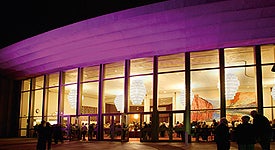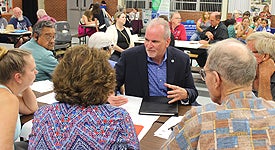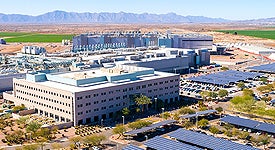Water is a precious resource in a desert. Chandler has spent decades securing a diverse water supply and building the infrastructure needed to efficiently deliver it.
The City has a comprehensive water management program that emphasizes water conservation and reuse. In fact, we reuse 100 percent of our wastewater through a reclaimed water system that supplements our potable supply. Chandler has a secure, reliable supply for businesses and residents during normal supply years, as well as during times of reduced supply.
Below are answers to frequently asked questions about Arizona's drought and how it affects the City.
Chandler's water comes from groundwater, reclaimed water, and surface water (water from rivers and lakes) from the Salt, Verde, and Colorado rivers. Salt and Verde River water is delivered to the Pecos Water Treatment Plant through the Salt River Project canal system. Colorado River water is delivered through the Central Arizona Project canal system to Chandler's Santan Vista Water Treatment Plant, a shared facility with the Town of Gilbert. Wells pump groundwater from below the surface to supplement drinking water supplies. Wastewater is reclaimed by cleaning it at Chandler's wastewater reclamation plants and is then used for irrigation and in lakes.
Drought is defined as three or more consecutive years of below-average precipitation falling on the watershed. Extended periods of below-average precipitation are normal in Arizona's desert environment. It does not mean there will be a water shortage in Chandler.
While the watersheds that supply Chandler's surface water may be in a drought, Chandler is well prepared and can weather this drought without mandatory water use restrictions. Chandler evaluates its surface water, groundwater, and reclaimed water supplies every spring and fall to determine if conditions specific to Chandler warrant activating its Drought Plan. Currently Chandler's water supply conditions do not warrant Chandler activating its Drought Plan. However, we are mindful this drought could last a bit longer and encourage using water wisely.
Chandler began preparing for droughts decades ago. As part of creating its water conservation ethic, Chandler started its water conservation programs in 1990. Chandler stores water underground to be used when surface water is in short supply. Every year, Chandler carefully analyzes its available water supplies and uses its surface water and reclaimed water first. Groundwater is used last. If water supplies are reduced in the Salt/Verde system or the Colorado system, Chandler could receive water from the surface water system not in drought, its vast groundwater reserves, or both.
Chandler's Drought Plan describes the demand reduction measures that will be implemented during severe drought conditions. The Drought Plan is designed for short term or year to year reductions. The Drought Plan has four stages, with each stage requiring a higher level response. Chandler uses drought declarations sparingly because studies have shown that after the drought declaration ends, water use returns to the previous levels, and sometimes increases. Chandler's water conservation programs instill a water conservation ethic among its water users. These programs lead to long-term, permanent water use reductions.
Every year, Chandler analyzes its available water supplies and uses its surface water and reclaimed water first. Ground water is used last. If one of Chandler's surface water supplies is low, Chandler will increase supplies from the Salt/Verde system to the Colorado system or vice versa. If necessary, Chandler can increase its well pumping and use its water stored underground. Even with the increased groundwater pumping during droughts, Chandler does not expect the groundwater levels to fall below their historic low levels. Once the drought is over, Chandler will reduce well pumping and groundwater levels will rise again.
Chandler is not restricting residences or businesses from over-seeding. However, as one of many practices residents can choose to save water, we encourage residents who are not bound by CCRs to refrain from over-seeding, not just during a drought, but as a way of life.
Chandler currently has no plans for water use restrictions. If future water supply conditions become severe enough, Chandler can implement voluntary water use restrictions. In Chandler, water conservation is a way of life. Chandler's ongoing water conservation ordinances and practices, which reduce water use, have been in place since 1990.
Short-term, year to year, drought responses temporarily reduce current water use and may not be sustainable over a long period of time. Chandler's water conservation programs are designed to instill a water conservation ethic. Chandler's strategy permanently reduces water use through its multiple water conservation programs. The programs include:
- Ordinances requiring all new construction to install water-efficient plumbing fixtures.
- Ordinances restricting the amount of turf and other water-intensive landscaping at newly constructed model homes, businesses, industrial facilities, and common areas that use drinking water for irrigation.
- Ordinances requiring all new landscape areas greater than 5 acres to use reclaimed water when available.
- Rebates for customers replacing turf with low-water use landscapes, installing low-water use landscapes in a new home, or installing a smart irrigation controller.
- Free water saver kits to Chandler residents living in homes built prior to 1992.
- Free water audits and leak detection services for unexplained high water use.
- Educational activities, such as free water conservation classes, informative brochures, public presentations, school education, and special events to increase awareness of the importance of conserving water.
- A water conservation webpage at chandleraz.gov/water and outreach on the City's various social media channels.
For more information about Chandler's Water Conservation Program, please contact the City's Water Conservation Office at conserve@chandleraz.gov or call 480-782-3580.
You can conserve water by watering your landscape at night or very early in the morning, install a low-water use landscape, not over-seeding for a winter lawn, making sure your irrigation system works efficiently, watering your lawn and plants efficiently, checking for leaks both inside and outside the home, installing low water use plumbing fixtures, using a broom instead of a hose to clean your driveway and sidewalk, running your dishwasher and laundry washer only when you have full loads, turning off the faucet while shaving or brushing your teeth and taking advantage of the various water conservation programs the City offers. Contact Chandler's Water Conservation Office at conserve@chandleraz.gov or call 480-782-3580 for more information, or visit wateruseitwisely.com for more than 100 ways you can save water.
Reclaimed water is an environmentally sound way of reusing water resources while saving drinking water supplies. Wastewater from our kitchens, laundry rooms, bathrooms, and sinks is collected and transported through a system of underground pipes to a water reclamation facility. Here it is extensively cleaned to meet the State's water quality standards. The reclaimed water is then used to irrigate non-edible crops, parks, golf courses, common areas and to supply water to lakes.
Most of the grass planted in common areas, golf courses, parks, and non-residential landscapes in south Chandler is irrigated with reclaimed water. All the lakes in south Chandler are supplied with reclaimed water and serve as reservoirs that store reclaimed water needed for irrigation. Purple irrigation boxes and signs identify areas using this resource. Using reclaimed water allows Chandler to conserve its drinking water for future generations. Areas where the turf is irrigated with reclaimed water can be overseeded during the winter months to allow the City to use reclaimed water year-round.
Many Valley golf courses use water that is not suitable for drinking, such as non-drinkable groundwater, untreated surface water and reclaimed water. Golf courses and resorts are an important part of Arizona's economic health, providing jobs and paying State and local taxes. A 1997 study by the Arizona Golf Association and the Arizona Department of Commerce estimated that statewide, golf facilities contribute over $900 million to the State's economy.
The City of Chandler has invested heavily in water reclamation facilities that treat our wastewater to A+ quality recycled water that meets all State standards for reuse and recharge. This ensures an otherwise wasted supply can be put to beneficial use, offsetting the use of drinking water. To date, more than 94 miles of reclaimed water lines have been installed in Chandler. Reclaimed water is available to most areas in South Chandler. In 2020, Chandler reused over 10 billion gallons of recycled water for irrigation of non-edible crops, parks, golf courses, common areas and to supply water to lakes. In addition, more than 2.7 billion gallons of reclaimed water was recharged into the underground aquifer for storage. This reclaimed water will be pumped out for future use.



